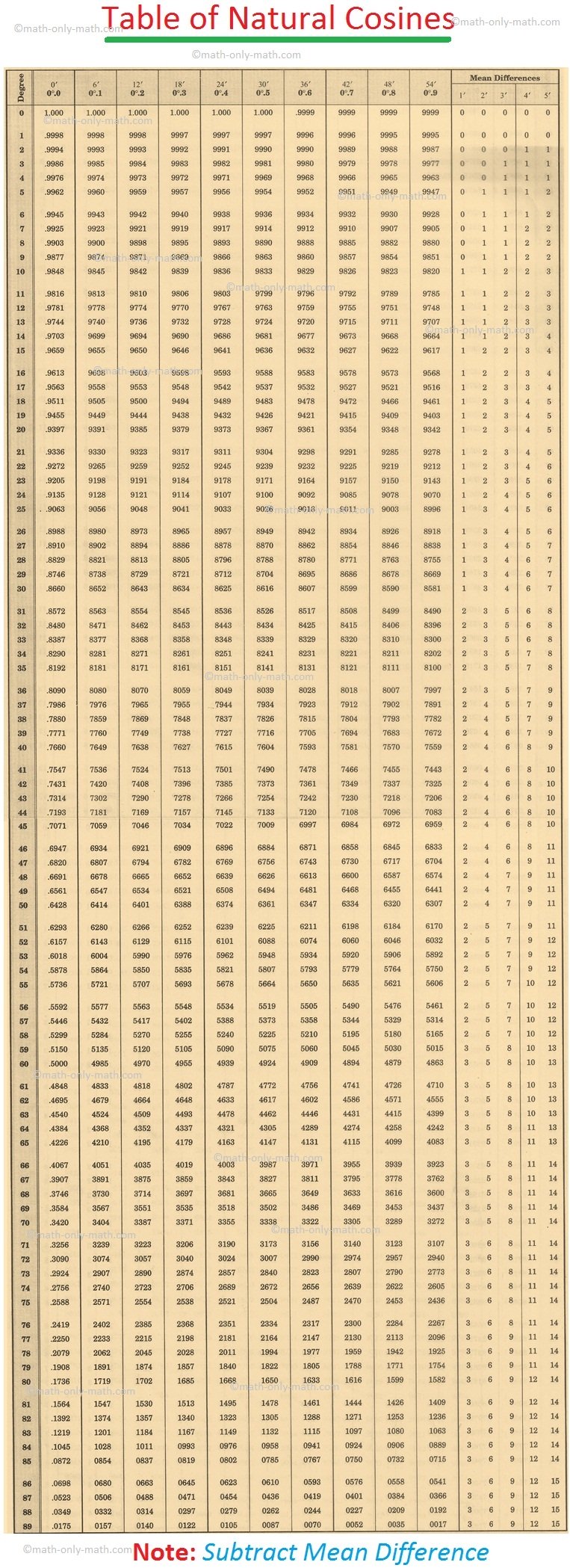Subscribe to our ▶️ YouTube channel 🔴 for the latest videos, updates, and tips.
Finding cos Value from Trigonometric Table
We know the values of the trigonometric ratios of some standard angles, viz, 0°, 30°, 45°, 60° and 90°. While applying the concept of trigonometric ratios in solving the problems of heights and distances, we may also require to use the values of trigonometric ratios of nonstandard angles, for example, sin 54°, sin 63° 45′, cos 72°, cos 46° 45′ and tan 48°. The approximate values, correct up to 4 decimal places, of natural sines, natural cosines and natural tangents of all angles lying between 0° and 90°, are available in trigonometric tables.
Reading Trigonometric Tables
Trigonometric tables consist of three parts.
(i) On the extreme left, there is a column containing 0 to 90 (in degrees).
(ii) The degree column is followed by ten columns with the headings
0′, 6′, 12′, 18′, 24′, 30′, 36′, 42′, 48′ and 54′ or
0.0°, 0.1°, 0.2°, 0.3°, 0.4°, 0.5°, 0.6°, 0.7°, 0.8° and 0.9°
(iii) After that, on the right, there are five columns known as mean difference columns with the headings 1′, 2′, 3′, 4′ and 5′.
Note: 60′ = 60 minutes = 1°.
1. Reading the values of cos 67°
To locate the value of cos 67°, look at the extreme left column. Start from the top and move downwards till we reach 67.
We want the value of cos 67°, i.e., cos 67° 0′. Now, move to the right in the row of 67 and reach the column of 0′.
We find 0.3907
Therefore, cos 67° = 0.3907.
2. Reading the values of cos 67° 48′
To locate the value of cos 67° 48′, look at the extreme left column. Start from the top and move downwards till you reach 67.
Now, move to the right in the row of 67 and reach the column of 48′.
We find 3778 i.e., 0. 3778
Therefore, cos 67° 48′ = 0. 3778.
3. Reading the values of cos 67° 41′
To locate the value of cos 67° 41′, look at the extreme left column. Start from the top and move downwards till you reach 67.
Now, move to the right in the row of 67 and reach the column of 36′.
We find 3811 i.e., 0.3811
So,
cos 67° 41′ = 0.3811 - mean difference for 5′
= 0.3811
- 14 [Subtraction, because cos 67° 41′ < cos 67° 36′]
0.3797
Therefore, cos 67° 41′ = 0.3797.
Conversely, if cos θ = 0.1097 then θ = cos 83° 42′ because in the table, the value 0.1097 corresponds to the column of 42′ in the row of 83, i.e., 83°.
From Finding cos Value from Trigonometric Table to HOME PAGE
Didn't find what you were looking for? Or want to know more information about Math Only Math. Use this Google Search to find what you need.



New! Comments
Have your say about what you just read! Leave me a comment in the box below. Ask a Question or Answer a Question.